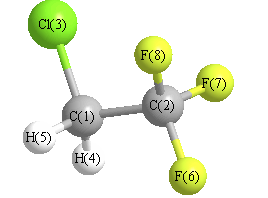Vibrational Frequencies calculated at CID/6-31G
| Mode Number |
Symmetry |
Frequency
(cm-1) |
Scaled Frequency
(cm-1) |
IR Intensities
(km mol-1) |
Raman Act
(Å4/u) |
Dep P |
Dep U |
|---|
| 1 |
A' |
3233 |
3024 |
3.43 |
|
|
|
| 2 |
A' |
1569 |
1467 |
17.09 |
|
|
|
| 3 |
A' |
1434 |
1341 |
21.90 |
|
|
|
| 4 |
A' |
1358 |
1270 |
171.93 |
|
|
|
| 5 |
A' |
1229 |
1150 |
220.95 |
|
|
|
| 6 |
A' |
861 |
805 |
25.97 |
|
|
|
| 7 |
A' |
781 |
731 |
23.24 |
|
|
|
| 8 |
A' |
623 |
582 |
41.31 |
|
|
|
| 9 |
A' |
512 |
479 |
12.61 |
|
|
|
| 10 |
A' |
350 |
327 |
1.10 |
|
|
|
| 11 |
A' |
186 |
174 |
2.73 |
|
|
|
| 12 |
A" |
3310 |
3096 |
0.39 |
|
|
|
| 13 |
A" |
1393 |
1303 |
129.34 |
|
|
|
| 14 |
A" |
1176 |
1100 |
109.48 |
|
|
|
| 15 |
A" |
965 |
902 |
8.25 |
|
|
|
| 16 |
A" |
512 |
479 |
5.23 |
|
|
|
| 17 |
A" |
353 |
330 |
1.87 |
|
|
|
| 18 |
A" |
100 |
94 |
5.21 |
|
|
|
Unscaled Zero Point Vibrational Energy (zpe) 9972.7 cm
-1
Scaled (by 0.9352) Zero Point Vibrational Energy (zpe) 9326.5 cm
-1
See section
III.C.1 List or set vibrational scaling factors
to change the scale factors used here.
See section
III.C.2
Calculate a vibrational scaling factor for a given set of molecules
to determine the least squares best scaling factor.
